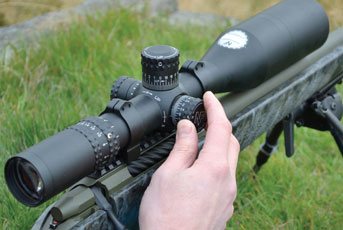Nightforce ATACR 5-25x56
- By Chris Parkin
-
0
 Comments
Comments
- Last updated: 16/12/2016

For many years Nightforce scopes, both NF and NXS models have been the benchmark by which other brands have been judged. With other makers surging beyond the once advanced 4x zoom range and mechanical adjustability, what have Nightforce done to keep up?
ATACR
The ATACR is Nighforce’s big step forward, although many looking for their take on the popular tactical market have got the B.E.A.S.T. in their sights, those with more realistic expectations may well target the Advanced TACtical Riflescope. The first features to catch the eye are the increase to a 34mm maintube and visually compact length. The 5-25 moniker alerts the fact that a 5x zoom range is now adopted and it starts to look very similar to the specifications shown by the leaders in the tactical scope market.
As well as the normal NXS traits of a one-piece maintube, included sunshade, side parallax dial and illumination switch incorporated, we now expect the fast turn turrets. Offering 20 M.O.A. per revolution, they have the zero stop to prevent us getting lost. With the reticule in the 2nd focal plane (SFP) I expect a FFP will appear in the future. Both the M.O.A.R and MIL-R reticules are available to match turrets calibrated in either option, the MIL turrets having 0.01mRad clicks. The hidden difference is the fact that larger maintube allows 120 MOA/34.9 mRads of elevation with half those values in windage too. This is outstanding but will it be coupled with top notch glass?
ONLY ONE WAY TO GO
For a long time, although superb mechanically, NF glass has sadly revealed its Japanese roots as light began to fade. Although offering superb lens grinding and sharp images at x32-42 magnification, colour rendition was good but not amazing and soon lost its sharp nature at last light.
The new ED glass offers fully multicoated optics and although rumours persist both ways, it carries all the hallmarks of European glass and lens coatings to my eyes. Colour definition is just that little bit sharper and the days I used it, the skies were very grey and overcast with that damp/dim autumn feel. I went straight into shooting the scope at range in competition as it came along with a test gun from an owner I KNOW to be an extremely good shot and fastidious for equipment preparation.
I’m a `clockwise` guy these days so I have to be careful when diving into distant shooting on a scope that runs the opposite way. Nightforce have always made nice turrets but to most users, the first 20 MOA is the most likely to see regular use and the fast turn zero stop units here allow that in one rotation. There is still a vernier scale beneath the dial but it is easier to just dial back to zero and re-count rotations if you are beyond the first turn. The tactile feel of the turret and clicks gives great feedback and didn’t overrun when dialled quickly.
THERE CAN BE ONLY ONE
If I could only shoot one comp, the McQueens would be it. I love the fast fire, rapid point of aim change and short distances really fun, never the same and it always seems a great baptism of fire for any scope. Field of view is critical as I like to see the whole arc of fire without moving the gun, then moving into the displayed target for the shot. This is often contrary to making a precise shot as scopes that don’t resolve a clear image at lower magnifications on a small target quickly fall foul.
Well the ATACR has both generous field of view and a razor sharp picture, performing both functions admirably. I did find the MOAR reticule very fine, especially in a fast fire situation with a dark target of contrasting colours. I could sense my eye jumping to the correct window/target quickly but then definitely searching for the centre cross. It is a `busy` pattern too. NF offer many reticules elsewhere and I think the choice is equally as important as magnification depending on your target type. For precision long range shooting on vermin, steel plates or silhouettes, the MOAR is great but just a little too much information for my eyes when shooting fast on small contrasting targets like a McQueen’s Head.
COMPACT
Illumination is the usual switch on the side of the parallax drum which dialled with no backlash onto targets. It is still controlled by a rheostat internally so isn’t immediately adjustable for light conditions on-the-fly so I set them up at their brightest and accept there may be a little flare. I only use it to speed up reticle acquisition in daylight. For low light use I would do the opposite.
The compact size of the scope is great. It runs a similar weight to its competitors at 1077 grams but is significantly more than 2” shorter than a Schmidt & Bender 5-25 which has virtually identical field of view and specifications! One other factor it shares with that Schmidt is the field of view stops increasing below 7x magnification. It is a factor that can invite critique in any scope as a black ring appears and some manufacturers claim it to be a `cheat`, not a true 5x erector tube.
BUT the exit pupil continues to increase in size and relative brightness which is generally why we zoom down, not for the tiny bit more field of view. The turrets certainly allowed accurate dialling between distances to the estimated `dope` figures I had input and further investigation showed a full 64 MOA available after zeroing on a zero inclination rail. Had a 20 MOA rail been used on this gun, this would have dialled me 300 yards beyond the bullet’s supersonic flight path.
